Fight to earn. Earn to eat. Eat to live. Live to fight. That’s the way of a Battle Brother.
Back in October 2014 Battle Brothers passed through Steam Greenlight. It then launched into Early Access in the April of the following year. At time of writing the developers are on the cusp of rolling out a new, major update for the game, moving them ever closer to their plans for 1.0.
Since entering into early access the developers have added new weapons, new origins for your Brothers, a quest system, a faction system, a new enemy type (poxy goblins), warhounds, rare & masterworks items, and a trade system with rare items and dynamic economy. Oh, and they’ve overhauled the skills system, armour system and map-generation procedure. Needless to say, for those of us who have been in the early access it’s been a whale of a time; and for those looking to join us in ownership of the game I fully believe it’s a solid buy. Let me explain why…
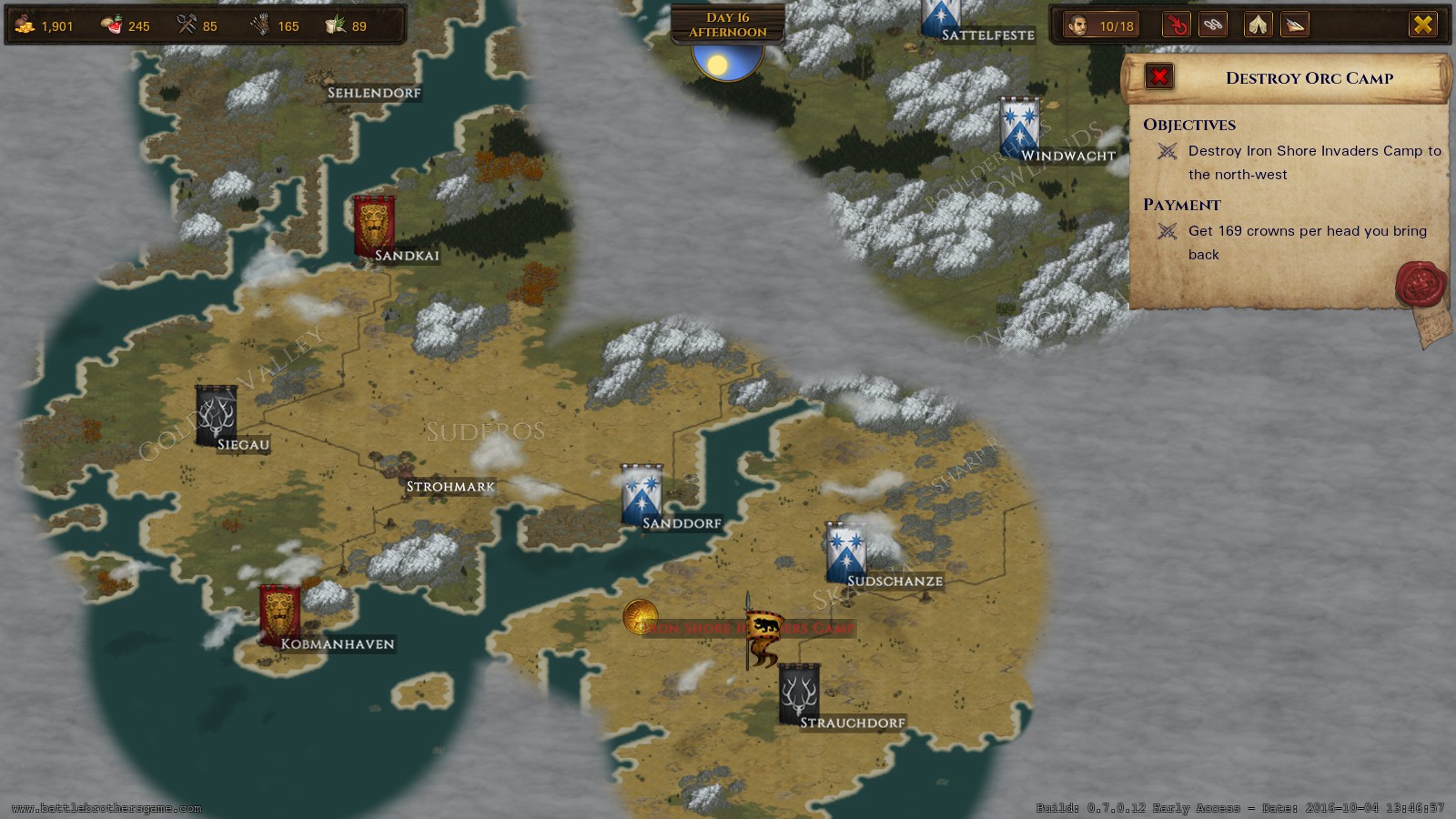
Battle Brothers takes the strategic open-world set up that made Sid Meier’s Pirates, and the Mount & Blade series famous, while keeping the squad count low (maximum of twelve in combat) and the danger high. As well as that, each of the characters in the game are generated on world boot, just like the map, and are only comprised of a handful of stats and perks, meaning that they’re more than malleable enough for you to go at least as attached to them as you did that XCOM colonel who you had to give up on to evaq the rest of the team.
As a matter of fact, where XCOM’s abilities and attacks are restricted to defined classes, Battle Brothers opts to go without a class system, meaning that you can equip a unit to serve as an Axe wielding damage dealer, but also have them be master to a war-hound, and carry a crossbow, for when the terrain forsakes your normal strategies. Of course, loading someone up with loads of stuff will leave them with less stamina, and ranged, max stamina and melee statistics (among others) ensure that there’s an obvious strength to how to use them; but, statistics be damned, you can have a fingerless, crippled brother practically static due to overexertion if you wish. You are, after-all, the commander.

As the commander you manage and oversee your troops and troops actions, load-outs contracts and more as you explore the game’s world (which is generated on game start) and ultimately steer the fate of your fighters and the company on the whole. Take too big a risk, with everyone ending up dead then that’s it, game over. It’s rather easily done too.
Alrik spots that these aren’t gravediggers, they’re the undead!There’s a lot of things out there to kill you, goblins, orcs, wolves, undead, and bandits. There’s even vampires and necromancers thrown in as well, although the game -despite appearances- is low fantasy, almost instead feeling like an alt proto-germanic fantasy setting. In fact, the game world definitely feels more like supernatural elements have spilt over into what would otherwise be a game about warriors in the early feudal states of Central/Eastern Europe.
In that, the game has no regard for formations and grand conflicts, with the fate of the game world revolving around pivotal skirmishes to stem the flow of evil. What this means for you, the player, is that there’s no class system, as you’ll need to swap your characters around to adapt. Holding a strong shieldwall together is no good if you’re at the bottom of a hill against spearmen and marksmen – it just means you’ll all die in a row.

Abilities, and attack types, are -as such- bound to the weapon in use. This means that if you have a character fighting as an opportunist archer, who doubles up with a polearm, you don’t need to go through any skill or attack set up – you change him to a machete wielder and boom, he can decapitate and cleave, give him a shield too and he can form a shieldwall (more on that later) and depending on the shield, do various other things too.
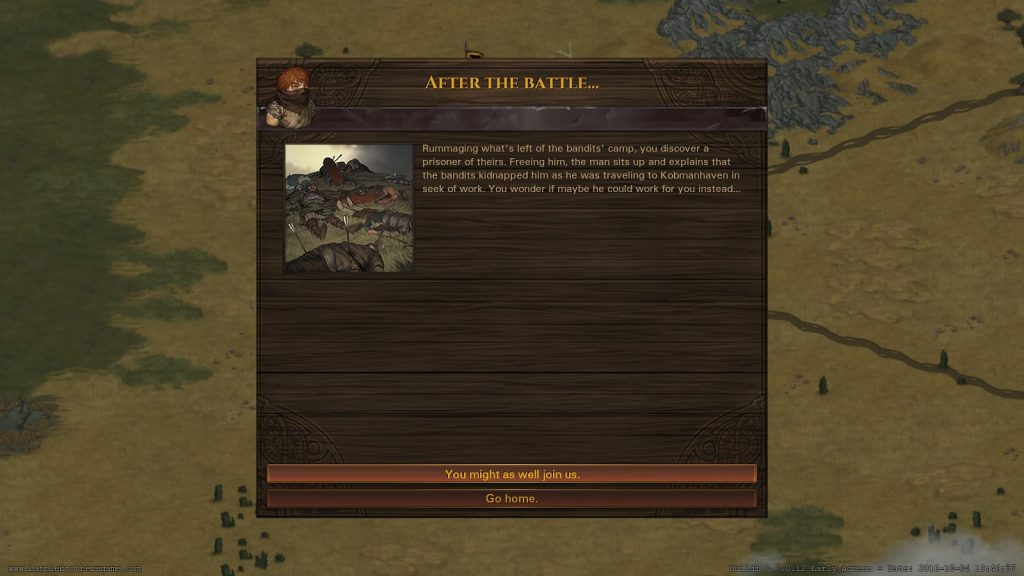
When you do take yourself into a battle, or get forced into one, each of the combatants are dominated by the statistics I mentioned earlier, each manipulated by base statistics depending on perks, events and load-out. Sure, there’s health, but more importantly there’s body armour, head armour, and initiative. There’s defensive and offensive statistics, but there’s also resolve and morale. These stats encompass and make transparent most of the variables (outside of the chance to hit, and attack damage) that affect you in combat, even showing their chance to hit the head, or effectiveness vs armour.
Of all those statistics however, one -for me at least- reigns king. Maximum Fatigue.
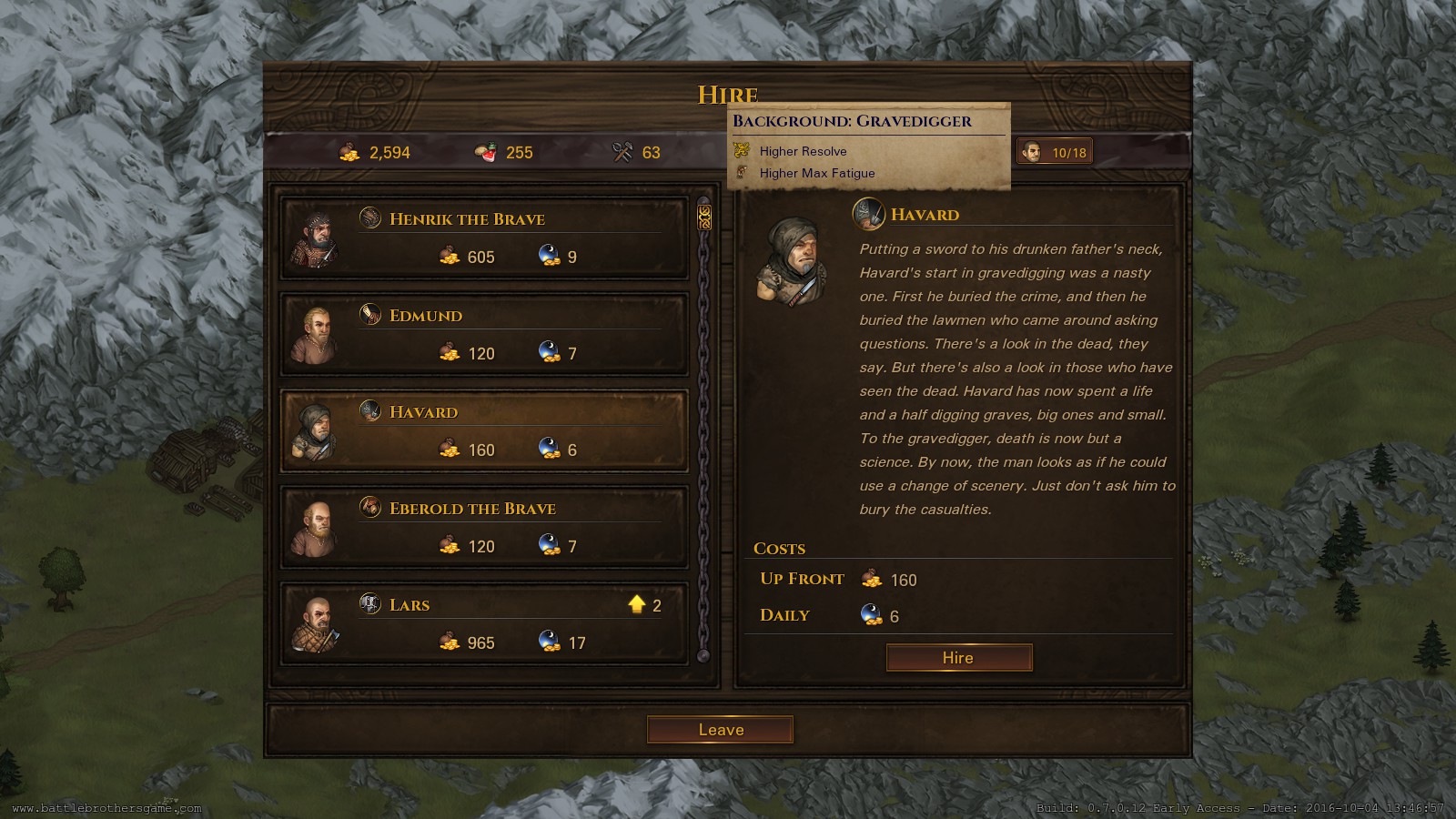
Each action in combat uses up Action Points -a mechanic there to ensure you don’t just one-man the entire enemy army with your godlike, noble, gut-stabbing, kidney-puncturing knife wielder- but also racks up fatigue points. Units regain about 15 of these fatigue points back at the start of each turn, but taking damage, or performing any type of skill -including defensive- will rack up the points.
In my current playthrough I’ve got a full combat arrangement of twelve, with nobody in back-up. Following a particularly tough run in with some bandits and dire wolves one of my characters, Havard, is down to 28 maximum fatigue, down from 70 due to a pierced lung (with about 3-4 days until the effects wear off). At 28 he is useless to my formation, the cleave attack builds up 18 fatigue, but the extremely useful decapitate skill builds up 30. We’re about to head into a bandit camp called Bloodwolves Court, and while bandits are generally easy to fell, their marksmen can be deadly, and, well, I said their easy to fell, everyone follows the same rules and so it’s easy to be overwhelmed even by ‘easy enemies’.
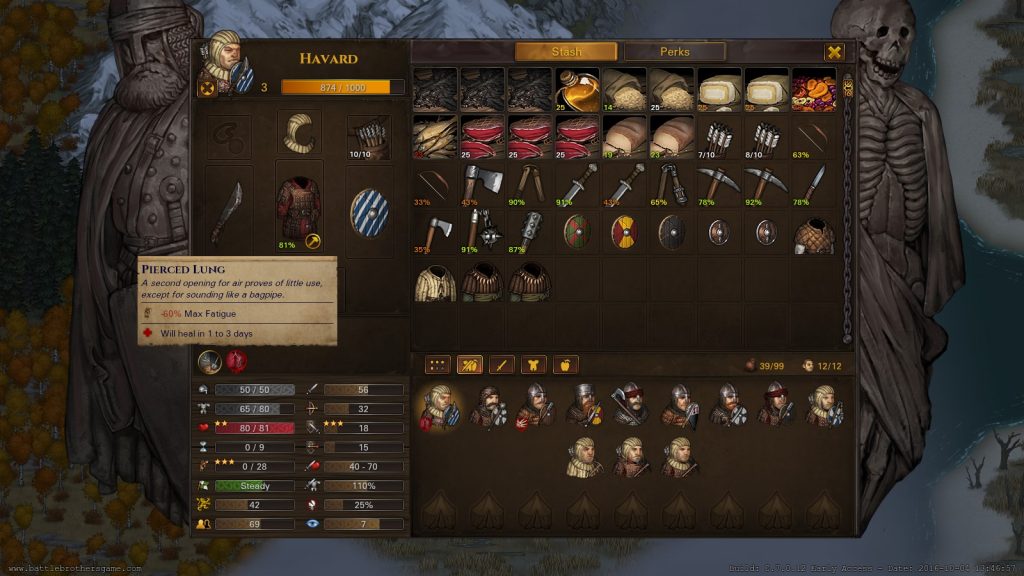
With the condition of Havard, the level 3 brother formerly a gravedigger, to consider, there are a few options on hand.
- Give up like cowards and head back to town, return later for the profit, hope that they haven’t reached out and grown stronger over time, starting new camps and gaining leader/hero units… which they will.
- Wait out the three-four days, during which we’ll have to feed and pay all of the brothers, and risk coming under attack anyway as the camp grows. This is bad practice as depending on how hard we fall on them, or they fall on us, the costs could easily outweigh the loot and gain.
- Do it anyway and watch Havard get turned into pudding by bandits if we make a single mistake.
- Have Havard sit it out in the camp with yours truly, hope that the numbers aren’t that close or we could have more injuries and deaths on our hands.
- Re-equip Havard with a crossbow, swap him out with someone in the backline who can multitask, or just hope the shieldwall or frontline can hold out, prevent flanking, and get the enemy marksmen before the line breaks and ranged characters need to take to melee combat.
I took option 5.

As an end result, Havard walked away alive from the battle. However, the front-line was split into two by flanking enemies; seven well equipped bandit raiders (a couple would be trouble if you’d just started out) split to attack my finesse fighters on the flanks, by the end of the turn a bandit leader had turned up. Leader units are essentially your legendary, or elite, units from each of the factions and depending on their equipment you’ll have to think on your feet to adapt.
I didn’t.
Two brothers died, including my double-handed axe wielder who I normally use to smash .through enemy shields and faces. The other was one of my mace-men, normally shattering armour so that my finesse troops can poke holes in the enemies without having to worry about sheets of metal getting in their way. Two other units were floored, but where we won the battle and they were lucky they were dragged away to fight another day, although each gained handicaps that will affect them for the rest of their careers. A weakened heart will knock 30% off the fighter’s maximum health – not good – while a missing finger will knock five percent effectiveness off all attacks. Ouch.

It’s likely that was the type of enemy different I would have met with an equal, or worse fate. Orc leaders are armoured to the teeth while their berzerkers do ridiculous levels of damage, but wear not armour. Goblins can ride wolves, but most importantly their marksmen fire poisoned arrows. The undead’s necromancer can bring the fallen skeletons back to life in an unlimited fashion until stopped – similarly the undead weidergangers and fallen heroes are likely to get right back up unless decapitated… shame on you for turning your backs on their bodies.
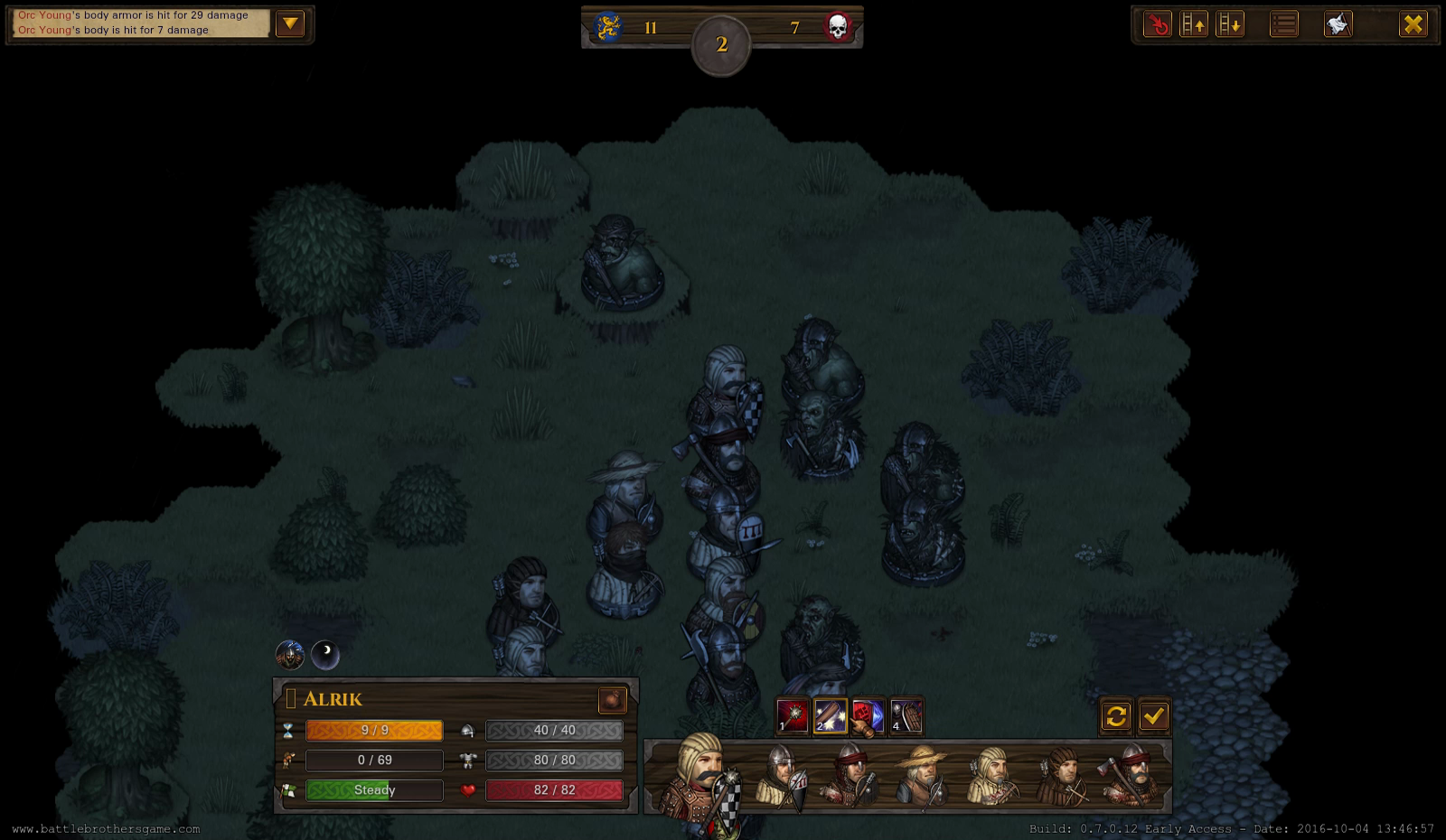
Shieldwalls, then, are only useful when the enemy plays to your rules. They give you a excellent defensive bonus but drain away your fatigue. In the most cases a solid wall can hold enemies for your back row to pick off (assuming the archers don’t shoot their brothers in the back of course), however when superior strength or tactics come into play it’s easy for a single unit to smash a shield free from an arm, hit for damage that avoids the armour, or even simply tear away your wall from the corners. Goblin Wolfriders, and teleporting vampires are exceptionally good at undermining this tactic, but then the charging orcs can completely knock a shield-wielder for six.
The Steam Community has been, since launch, rife with people discussing tactics – a front row of crossbowmen firing a rally before swapping to bastard swords, a backrow of polearm users to attack from behind a shieldwall, using war-hounds to flank enemies when the battle is in the full heat. The variety of mid to late game tactics discussions is really a testament to the depth of the game’s combat diversity.
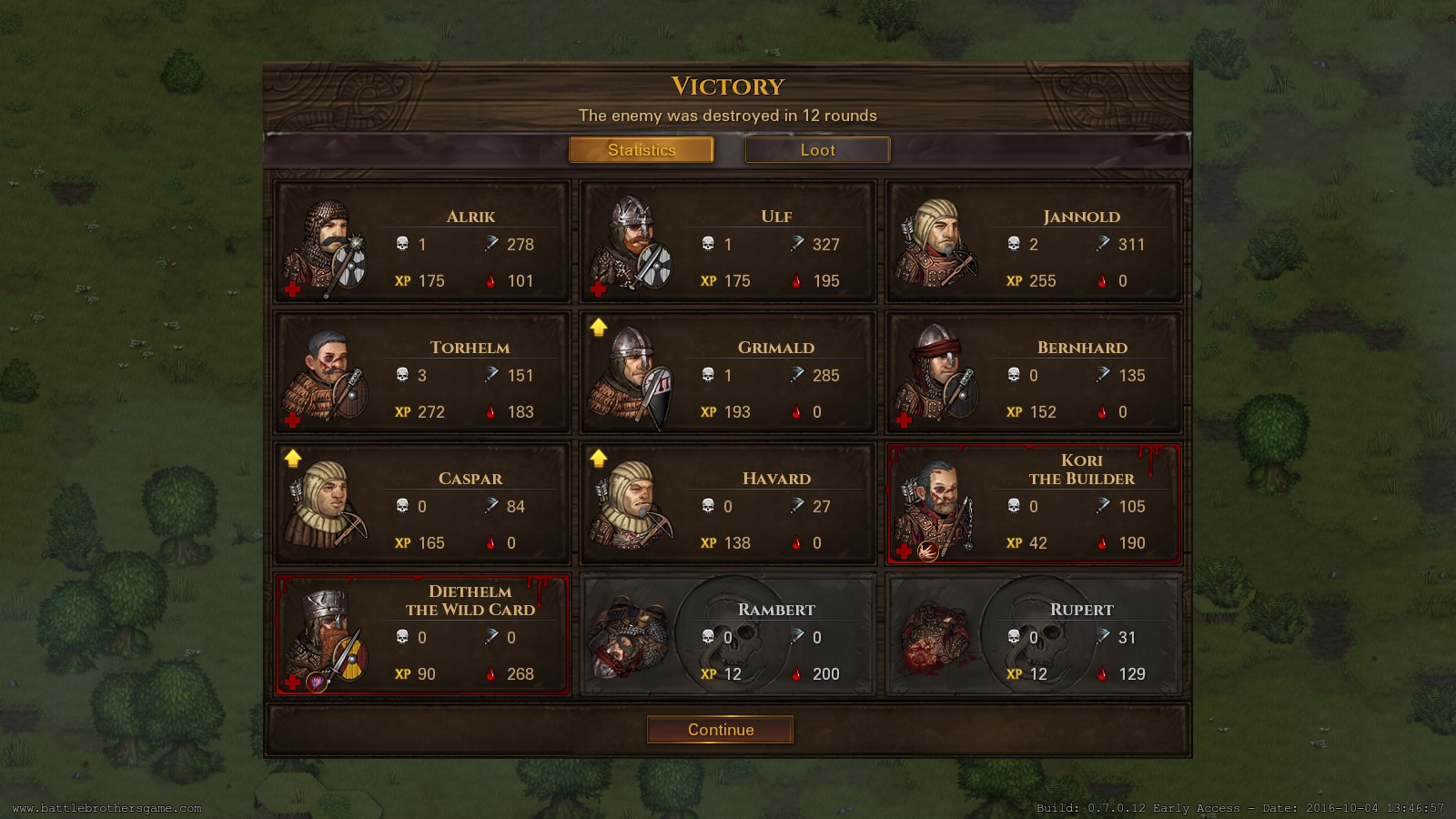
There are some negatives with the game at its current build-state. Rivalling factions will unite against you even when the decision should have resulted in a three-way battle, something the game engine cannot manage at the moment. This is only a bad thing in that it’s immersion breaking; when eighteen bandits team up with six weidergangers to fight you, or some bandits join up with dire wolves to attack you. It’s also a tad unfair as different enemy types us different tactics. That said, I did survive both of those conflicts, mostly due to the speed differences between the groups.
The fact that your troops can not spend action points to sever the head of fallen undead is also odd, especially once you’ve fought several of them and so know the likelihood of them returning. It could be a brilliant waste of time, or effective prevention if the chance to attack them when down was added in.

Human towns can become economically stronger through successful trade efforts, or crippled by enemy attacks, but unlike the enemy factions they can never grow more plentiful — if the world map was a lot larger, there were less (but stronger) cities at the start, and humans could push forward into the frontiers then it would certainly add a lot more variance to the already varied world generation. The main negative of this would be that the villages/towns would then need to be destructible, and the frontier jobs -unless managed by the human factions- would not be as profitable due to wealth. It’s a Pandora’s box of a juggling act, which is probably why it’s been avoided.

Finally while the event system is diverse -with a lot subject to traits and history- a lot of quests seem to repeat, especially the initial faction ones. As well as the fact that the game has no current driving force outside of surviving to fight another day. That said, both of these are listed as being addressed before the game reaches 1.0, which is some point on the horizon.
Plans for the future for the game currently include more events, infighting between human factions, an evil force driving deeper into the world, as well as a whole lot more. The next big step is something to do with the world map, that is, once the new art style has rolled out.
Battle Brothers has easily been one of the best executed experiences of Early Access that I’ve had the pleasure of being part of. It’s currently scheduled to hit 1.0 at some point next year, after one more major update, and no-doubt a few more tweaks.
